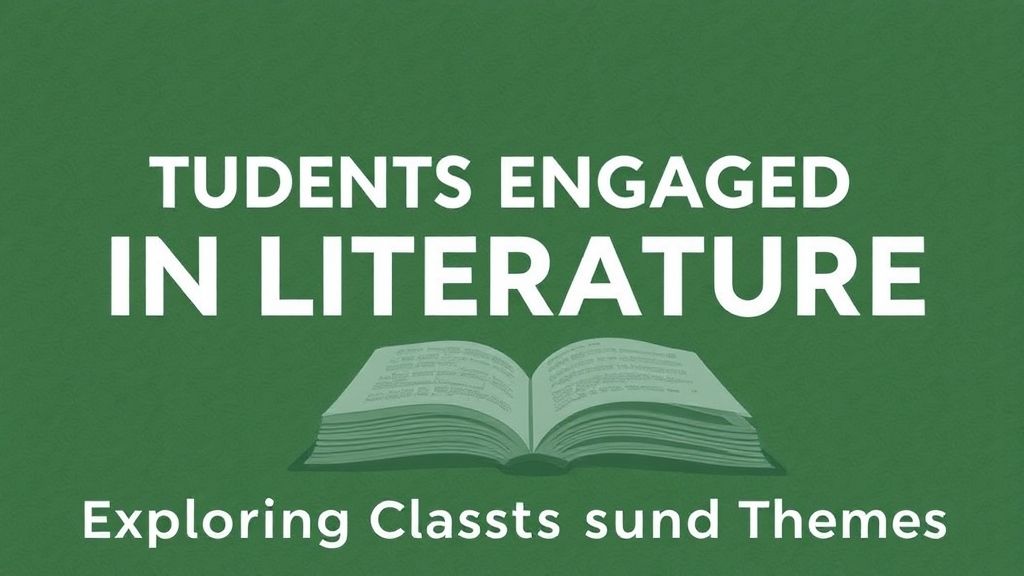Unlocking English Literature: Your Comprehensive History Notes
Reading Time: 12 minutes
Key Takeaways
- Understand the chronological development of English literature from Anglo-Saxon to Victorian eras.
- Identify key characteristics, major authors, and influential works of each literary period.
- Connect literary movements with their historical, social, and cultural contexts.
- Learn effective exam preparation strategies, including syllabus alignment and potential question types.
- Gain insights into comparative studies and critical analysis for deeper understanding.
Table of Contents
Feeling overwhelmed by the sheer volume of names, dates, and movements in your English Literature syllabus? Many students stare at the extensive reading lists, from the ancient tales of Beowulf to the complex narratives of modern times, and wonder how they’ll ever get a grip on it all. You’re not alone! The vast landscape of English literature can seem like a daunting mountain to climb, especially when exam success depends on understanding its intricate details.
But what if you could turn that mountain into a captivating journey? This blog post is designed to be your essential compass, offering comprehensive History of English Literature notes that will not only simplify your study but also ignite a genuine appreciation for the stories, poems, and plays that have shaped our world. Forget rote memorization; we’re here to help you understand the why and how behind literary masterpieces.
Here, we will unveil the key historical periods and major works that have carved out the rich tapestry of the literary landscape. We’ll take you on a chronological adventure, from the very beginnings of Old English literature right up to contemporary writing. You’ll explore iconic eras like the Renaissance, where Shakespeare’s genius blossomed, and the passionate outbursts of the Romantic period, bringing you face-to-face with the literary giants who defined their times. We’ll highlight the characteristics, key authors, and defining texts of each era, giving you the structured History of English Literature notes you need to excel.

Beyond just learning about different periods, we’ll explore how these narratives aren’t just fictional tales but powerful mirrors reflecting profound societal changes. Imagine how the Industrial Revolution, with its stark inequalities, spurred writers like Charles Dickens in the UK to create vivid stories of poverty and social injustice. Or how the struggle for independence in India inspired revolutionary poetry and prose from figures like Rabindranath Tagore, shaping national identity. Literature, whether from England or India, is constantly in conversation with its environment, offering unique insights into human experience, politics, and culture across centuries.
Even more fascinating is how these historical works continue to influence modern literature, music, and even film today. The themes of love, loss, power, and identity explored by centuries-old writers still resonate, proving their timeless relevance. Understanding this journey through English literature isn’t just about passing an exam; it’s about gaining a deeper insight into humanity itself. So, if you’re ready to transform your understanding of the History of English Literature notes from a confusing jumble into a coherent, captivating narrative, you’ve come to the right place. Let’s embark on this enlightening exploration together!
1. Overview of English Literature
Understanding the History of English Literature notes isn’t just about memorizing names and dates; it’s about charting a fascinating journey through human thought, emotion, and societal change. From the ancient epics chanted around Anglo-Saxon fires to the complex narratives of our contemporary world, literature has always been a mirror, reflecting and shaping the cultures from which it springs. This section will give you a bird’s-eye view, preparing you for a deeper dive into each era.
Historical Context: English literature boasts a timeline stretching over 1500 years, beginning with its Germanic, Anglo-Saxon roots, deeply intertwined with oral traditions and warrior cultures. It then evolved through the French influence of the Norman Conquest, the rebirth of classical learning during the Renaissance, the age of reason in the Enlightenment, the emotional intensity of Romanticism, the social critique of the Victorian era, and into the experimental forms of Modern and Postmodern literature. Each shift in society—be it political upheaval, religious reformation, or scientific discovery—left an indelible mark on the stories told and the way they were told.
Key Characteristics: Across these diverse periods, certain themes and styles emerge, defining each movement. Early literature often focused on heroism, fate, and faith. Later, humanism, reason, and individual liberty became central. As societies industrialized, literature tackled social inequality, realism, and psychological depth. More recently, fragmentation, ambiguity, and self-awareness characterize contemporary works. Recognizing these key characteristics is vital for your History of English Literature notes and for understanding the unique flavour of each period.
2. Major Literary Periods
Let’s embark on a chronological exploration of the foundational periods that built the rich tradition of English literature.
A. The Anglo-Saxon Period (450-1066)
This earliest period of English literature is defined by epic poems and religious texts, often transmitted orally.
- Key Works: The most prominent text is Beowulf, a heroic epic poem. It explores themes of courage, loyalty to one’s lord, the struggle between good and evil, and the acceptance of fate (“Wyrd”). This period also saw elegiac poems like “The Wanderer” and “The Seafarer,” expressing solitude and the transience of life.
- Influence: Tribal culture, where bravery and honor were paramount, heavily shaped these narratives. The fierce Germanic warrior code combined with emerging Christian values created a unique literary voice.
B. The Medieval Era (1066-1485)
Following the Norman Conquest, English language and literature absorbed French influences, leading to new forms and themes.
- Notable Authors: Geoffrey Chaucer is the towering figure, whose The Canterbury Tales offers a vibrant, satirical snapshot of medieval society through its diverse pilgrims and their engaging stories.
- Literary Forms: This era saw the rise of popular ballads, short narrative songs passed down orally, often telling tales of romance or adventure. Morality plays, such as Everyman, used allegorical characters (e.g., Death, Good Deeds, Knowledge) to teach moral lessons about salvation and Christian living.
C. The Renaissance (1485-1660)
A period of profound ‘rebirth’ in art, science, and literature, characterized by a renewed interest in classical learning.
- Cultural Shifts: Humanism, an intellectual movement emphasizing human potential and achievement over divine revelation, was central. The rediscovery of Classical Greek and Roman texts inspired new forms and ideas.
- Key Figures: William Shakespeare stands as the unparalleled giant. His plays like Hamlet, Romeo and Juliet, and A Midsummer Night’s Dream explored universal human emotions, psychological depth, and complex moral dilemmas, forever changing drama and the English language itself.
D. The Enlightenment (1660-1798)
Often called the Age of Reason or the Neoclassical Period, this era valued logic, order, and scientific inquiry.
- Characteristics: Empiricism (knowledge through experience) and reason were the guiding principles. Literature often championed clarity, wit, and social satire.
- Major Works: Jonathan Swift’s Gulliver’s Travels brilliantly satirized human nature and political corruption. Alexander Pope’s mock-epic poem The Rape of the Lock perfectly exemplifies the era’s wit, precision, and adherence to classical forms.
E. The Victorian Era (1837-1901)
Named after Queen Victoria, this long period was marked by rapid industrialization, social change, and technological advancement.
- Themes: Literature grappled with the profound impact of industrialism, social inequality, class struggle, and evolving moral questions. Realism, depicting life as it truly was, became a dominant style.
- Key Texts: Charles Dickens vividly exposed social injustices in novels like Great Expectations and Oliver Twist. The Brontë sisters (Charlotte with Jane Eyre and Emily with Wuthering Heights) explored passionate emotions, female agency, and challenging social norms, deeply influencing the development of the novel.
3. Exam Preparation Strategies
Mastering the History of English Literature notes is crucial for your exams. Here are some strategies to help you excel:
- Syllabus Tie-Ups: Regularly consult your university syllabus (e.g., Delhi University BA English Honours, Mumbai University MA English) to see how these periods, authors, and texts align with your specific course requirements. Our notes are designed to cover typical syllabus topics.
- Revision Points:
- Anglo-Saxon: Beowulf, heroism, fate, oral tradition, Christianity.
- Medieval: Chaucer (Canterbury Tales), allegory, morality plays.
- Renaissance: Shakespeare, humanism, drama, classical influence.
- Enlightenment: Reason, satire, Swift, Pope, birth of the novel.
- Victorian: Industrialism, social issues, realism, Dickens, Brontë sisters.
- Potential Exam Questions:
- “Discuss the role of fate and heroism in Anglo-Saxon literature with reference to Beowulf.”
- “How does Geoffrey Chaucer’s The Canterbury Tales reflect the diverse social strata and emerging individual voices of the Medieval period?”
- “Analyze how Renaissance humanism influenced William Shakespeare’s portrayal of characters in his tragedies.”
4. In-Depth Analysis and Comparisons
Beyond individual periods, a deeper understanding comes from connecting and comparing literary movements.
- Comparative Studies: Consider comparing the Enlightenment’s emphasis on reason and order with the Victorian Era’s focus on social realism and the complexities of human emotion. While the Enlightenment satirized human folly to promote rationality, the Victorians often presented nuanced characters grappling with moral dilemmas amidst industrial turmoil, moving from abstract reason to concrete social critique.
- Critical Insights: Literary interpretations are dynamic. Engage with scholarly debates around authors (e.g., varying feminist readings of Jane Austen) or themes (e.g., the shifting perception of colonialism in Swift’s Gulliver’s Travels). This shows a critical engagement beyond simple summaries.
5. Additional Resources
To further enrich your History of English Literature notes and understanding:
- Further Reading: Consult academic resources such as The Norton Anthology of English Literature, The Cambridge History of English Literature, or scholarly journals for deeper insights into specific periods and authors.
- Glossary of Terms: Familiarize yourself with key literary terms (e.g., allegory, satire, tragic flaw, stream of consciousness, poetic justice) to articulate your analysis precisely.
Wrapping It Up
We’ve embarked on an illuminating journey through the vast and captivating History of English Literature notes, from its earliest chants to the complex narratives of modern times. This exploration has unveiled the profound connections between texts and their societal influences, demonstrating how literature is not merely a collection of stories, but a living record of human experience, thought, and culture across centuries. We’ve seen how Beowulf reflected Anglo-Saxon tribal courage and fate, how Chaucer’s Canterbury Tales mirrored medieval society, and how Shakespeare’s genius blossomed amidst the humanism of the Renaissance. The Age of Reason brought us the sharp wit of Swift and Pope, while the Victorian era saw authors like Dickens and the Brontës grapple with industrialism and profound social change. Delving into the intricate layers of each literary era offers compelling insights, transforming what might seem like a daunting syllabus into a rich, interconnected narrative. Understanding these historical and thematic threads is not just about passing an exam; it’s about gaining a deeper appreciation for the enduring power of words.
Join Us at EnglishLabsIndia
This blog post has provided a comprehensive overview, equipping you with essential History of English Literature notes and strategies. But this is just the beginning of your literary adventure! To truly master this subject, deepen your knowledge, and excel in your academic pursuits, we invite you to become part of our vibrant EnglishLabsIndia community. Here, you can access an unparalleled treasure trove of detailed notes, exclusive video recordings, and expertly curated study materials that break down complex literary concepts with clarity and precision. Our resources are designed to make even the most challenging texts accessible and enjoyable. Don’t miss out on our upcoming seminars, including the insightful Srijan Tirtha series, where experts delve into specific literary topics, offering invaluable perspectives and interactive learning opportunities. And, of course, keep an eye on our blog for upcoming posts that promise to provide deeper insights into the next fascinating literary periods and critical analyses. Let EnglishLabsIndia be your trusted companion on your journey to mastering English Literature – your academic success is our priority!
